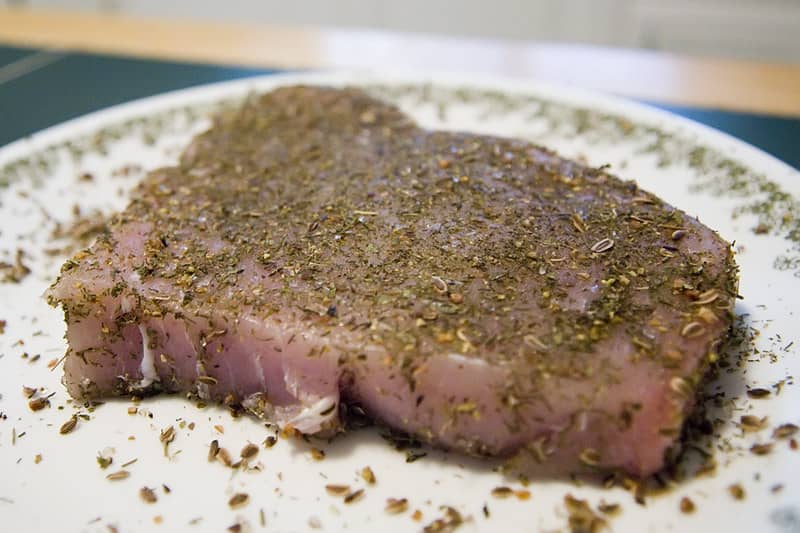
Cows aren’t the only animals that produce steaks. Fish steak is also a thing, and one of the most popular types of fish steak comes from swordfish, a mild-tasting fish usually found in tropical ocean zones. Swordfish steaks can be a healthy option to add to your meal plans, but if you’re not experienced with cooking fish, you should have a few pointers to help you get it right.
In this guide, we discuss tips and tricks for choosing and cooking swordfish steak along with some of the best cooking methods for this particular fish.
What is Swordfish Steak?
Swordfish steaks are pieces of swordfish cut into steaks of about one inch thick. Typically, each swordfish steak weighs about 8 ounces, and you can get multiple steaks from one average-sized swordfish.
Swordfish meat is on the milder side of the taste range, which makes it a good option if you’re not a fan of stronger flavors like salmon or herring. However, swordfish does have a somewhat dense texture that’s more like salmon than flakier fish, like tilapia or cod, and the chewiness can be a turn-off for some.
Like other fish, swordfish meat offers various health benefits, like being rich in healthy fats and protein and being an excellent source of necessary vitamins, zinc, vitamin B12, vitamin D, and selenium.
How to Choose Swordfish
When looking for swordfish at the supermarket, you may find it fresh or frozen. Either option should have slightly pink to slightly orange flesh. You’ll also notice a bright red bloodline running through the meat, which indicates high-quality meat. If this bloodline is dark brown or grayish, the swordfish likely isn’t as fresh.
When looking at frozen swordfish, make sure the fish or steaks are wrapped airtight to keep air from coming in and affecting their quality. For fresh swordfish, look at the sell-by date. If that’s still within range, examine the swordfish steaks more closely. Do they look discolored in any spots, have a slimy film covering them, or feel mushy to the touch? Any of these points could indicate an issue with the swordfish steaks’ freshness.

Tips and Tricks for the Best Swordfish Steak
There are a few things to keep in mind as you prepare and cook swordfish steak for the best results:
- It’s not the same as other fish: Swordfish steak is unique in that it’s meatier and less delicate than other fish. Therefore, you don’t have to be quite as careful cooking it as you would, say, tilapia or halibut. If you want to place it directly on your grill grates, you can—just make sure your grates are clean and well-oiled before you start.
- Avoid flipping too much: Yes, swordfish steak is relatively hearty for fish. Still, similar to burgers, you don’t want to flip it too much when cooking, as it can make the fish fall apart. Instead, cook it for several minutes on one side before flipping it just once to the other side.
- Give it time to rest: Like other meats, swordfish steak needs a few minutes to rest before you enjoy it. Resting time lets juices and their associated flavors distribute throughout the meat.
Ways to Season Swordfish
Swordfish doesn’t have a ton of flavor on its own, which can actually be a good thing when you want a lot of seasoning options. It’s a blank canvas for seasoning, so you can go as simple as some salt and pepper to more robust flavors, like a citrus-lime seasoning blend.
Whatever seasoning you choose, be sure to pat the swordfish dry thoroughly before brushing on a light layer of olive oil, which helps the seasonings adhere to the fish. Then, sprinkle on your seasoning blend, using your fingertips to gently spread the mixture on both sides of the swordfish. Here’s a simple seasoning blend that works beautifully with swordfish steaks:
- 2 tbsp crushed garlic cloves
- 1 tbsp lemon zest
- 1 tsp Kosher salt
- 1 tsp ground black pepper
- 1 tsp finely chopped basil

To Marinate or Not?
It’s also common to marinate swordfish steaks instead of seasoning them. Because swordfish is naturally milder in flavor, marinating swordfish steaks for a few minutes helps the fish soak up extra flavor. However, remember that fish is more delicate in general than beef or chicken, so you only need a few minutes (about 15) of marination. More than that, and the marinade can begin to break down swordfish steaks.
Try this delicious marinade for swordfish steak:
- 2 tbsp soy sauce
- 2 tbsp olive oil
- 2 tbsp minced garlic
- 1 tbsp white wine vinegar
- 1 tsp dried cumin
- 1 tsp dried basil
- 1 tsp dried rosemary
- 1 tsp lemon zest
- ½ tsp black pepper
- ½ tsp paprika
The Best Methods For Cooking Swordfish Steaks
Below, we explain how to cook swordfish steak on the grill, on the stove, in the oven, and in the air fryer. Pick your favorite or experiment with each cooking method to decide which one yields the best results.
Grilling Swordfish Steaks
Pat the swordfish dry. In a bowl, combine the ingredients for the marinade described above. Add the swordfish to the bowl to marinate while you preheat the grill to 400°F, flipping it over once to allow the marinade to reach both sides.
Move the swordfish to the grill and cook for 4-5 minutes. Flip the steak to the other side to cook for another 3-4 minutes. Use a thermometer to check the temperature. Remove the steaks from the grill when they reach 125°F. Then, let them rest at room temperature for about 5 minutes before serving. The final temperature should be between 130-135°F. Squeeze lemon over the swordfish steaks just before enjoying.
Swordfish Steak on the Stove Top
Don’t want to fire up the grill? Cook swordfish steak on your stove instead.
Let your steaks marinate for about 15 minutes as you preheat a large skillet with a drizzle of olive oil to high heat. Carefully remove the steaks from the marinade and move them to the pan. Sear for 4-5 minutes on one side before flipping to the other side to sear for another 3-4 minutes.
Remove the steaks when they reach 125°F, and let them rest at room temperature for 5 minutes. Serve with lemon wedges.
Swordfish Steaks in the Oven
Pat the swordfish steaks dry and season them with salt and pepper. Or, use our marinade recipe to marinate the swordfish steaks for about 15 minutes while you preheat the oven to 350°F.
Move the swordfish to a baking dish and, if you used marinade, pour the remaining marinade over the top of the fish steaks. Bake the steaks for 8-10 minutes before flipping them and baking for another 8-10 minutes. A thermometer inserted into the thickest part of the steak should read 125°F before removing the steak from the oven.
Rest at room temperature for 5 minutes. The temperature should rise to 130-135°F during this time. Squeeze fresh lemon juice on top of the swordfish steaks just before serving.
Air Fryer Swordfish Steak
The air fryer can be a good alternative for cooking your swordfish steaks on a hot day instead of heating your kitchen with the oven.
Marinate the swordfish steaks using the recipe above while you preheat the air fryer to 400°F. Add the steaks to the air fryer basket, working in batches if necessary to ensure each steak doesn’t touch. Cook for 4-5 minutes. Then, flip the steaks to the other side to finish cooking for another 4-5 minutes.
Rest for 5 minutes at room temperature, and serve with lemon wedges.
How Do You Know If Swordfish is Done?
The best way to check if your swordfish is cooked thoroughly is to use a digital thermometer. Cooked swordfish should reach 130-135°F when the thermometer’s probe is placed into the thickest part of the meat.
You can also check the swordfish’s color to ensure a thorough cook. Cooked swordfish that’s safe to eat will be opaque and white, while undercooked swordfish will be more translucent and lean toward a pink or gray hue.
Conclusion: How to Cook Swordfish Steak
Go ahead and try each method for cooking swordfish steak to find the one you like best. Each is just as easy to accomplish and yields delicious swordfish, so it’ll mostly boil down to your cooking equipment preference.
Then, when you’re ready to experiment some more, head over to Steak University for more cooking guides, tips, and recipes for everything from steak to side dishes. Also, check out Chicago Steak Company’s Fresh Fish Market to order grouper, cod fillets, salmon, Mahi Mahi, and more, straight from our top-of-the-line facilities to your home.


